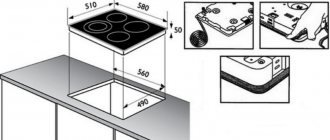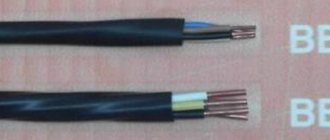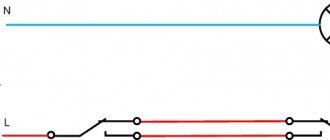Connection diagrams
There are many schemes for connecting a TV connector. A splitter is used to process the signal. This device looks like a small box and performs the function of signal separation. Just like in telephone lines, when transmitting digital electrical signals, you cannot do without their separation.
The principle of operation of a splitter is to divide the signal into equal packets. Next, the divided segments are transmitted to the input part of the television connectors. The splitter is designed in such a way that all TVs receiving the signal, regardless of their number, will receive a signal of equal quality. As a result, within the same apartment there is no point in having a separate antenna for each TV.
The connection can be made in one of two ways:
- The “star” scheme, when the old cable is removed and the new one is laid through the splitter.
- Daisy chain circuit.
Below we will look at the question of how to connect an outlet, while paying attention to the advantages of the circuits under consideration.
Star pattern
This circuit uses a splitter that performs the function of branching the signal, breaking it into packets and amplifying it. The device is placed at the cable entrance to the living space from the entrance. Next, antenna conductors are distributed to consumers. Installing a TV outlet using this simple technology is most often used, since the splitter provides a number of advantages:
- The cable is located in a technically protected place, which is important both during installation work and during further preventive inspections.
- The signal is stable.
- Separated signal packages are uninterruptedly supplied to all television receivers in the apartment.
Daisy chain connection
This method of installing a TV outlet involves the use of a cable. The main cable is routed to any of the TVs in the house, and then it is routed to other receivers directly at the connector. The wiring is a branch into two or more parts (depending on the number of TVs available).
Connecting in this way is called daisy chain. In this case, the connectors connected by a cable must be feed-through, except for the last one, which is the terminal one.
The daisy chain circuit allows you to save on cable consumption, but it also has disadvantages. The disadvantage of a daisy chain system is that the quality on the first receiver will be higher than on subsequent ones.
However, if the television signal is strong enough, the difference will be almost unnoticeable.
In addition, one should take into account the fact that modern television equipment is equipped with the ability to amplify the signal, and this happens automatically. Daisy chain connection through pass-through television sockets
So, the uneven distribution of the signal in this case can be considered an insignificant drawback. Other disadvantages of the loop system include the following:
- The circuit, where there are pass-throughs and a terminal TV socket, will cost more than the standard “star” circuit.
- If the circuit breaks, all subsequent consumers are deprived of a television signal.
Installation using the example of a Schneider socket
As an example, let’s look at the installation of a pass-through socket from a French one (model socket tv rj45). The task is to connect two TVs to one cable using a loop-through circuit.
When installing a socket for a TV cable, we provide a small excess of the cable itself - it should come out of the installation box. Next, we strip a small section of the insulating material on the cable. At the same time, we keep the central core and shielding braid intact.
We start by removing the front panel and slightly unscrew the clamping bolt. This is necessary to ensure that the cable exits freely through the hole.
There are arrows on the connector body. Insert the cable all the way in the direction indicated by the arrows. Then we press the cable with a clamping screw (tighten it). The cable must be securely fastened, but the screw must be tightened with care so as not to crush the line. We perform exactly the same manipulations with the second end. We install the connector in such a way as to avoid kinks on the cable.
Note! Before installing a television outlet, you should inspect the area where the wire is fixed for the possibility of a short circuit in the main core with the braid.
When the cable is inserted and secured, put on the front panel. The panel is fixed using special proprietary latches. Using a building level, we check the accuracy of the horizontal installation of the connector. If everything is in order, we finally fix the panel with fastening bolts and cover it with a frame.
Connecting the Lezard connector
Sockets from are inexpensive and of good quality. However, when choosing Lezard products, you need to take into account the presence of a printed circuit board on it. The fact is that the boards are equipped with a component such as a capacitor. This part is located next to the center core retainer and the cable connector. The capacitor is impermeable to the supply voltage that must be supplied to the active antenna. Therefore, such connectors are suitable exclusively for passive antennas.
If you still want to adapt such a socket for an active antenna, you need to install a standard conductor instead of a filter capacitor. This is done by short-circuiting and soldering a piece of copper wire instead of the capacitor.
The actual connection of a TV socket consists of installing the signal conductor of the TV cable in the central socket terminal. You also need to secure the screen with a bracket.
Note! The main conductor that transmits the signal must not be short-circuited with the braid. Otherwise, the screen that protects against loss of the television signal in the cable will be damaged.
Connecting the Legrand connector
The TV socket differs from the French one in its ease of connection, but is also quite expensive.
When connecting the connector, fix the central cable core in a special spring clamp. We press the foil braid to the body using a folding fastener.
We remove the fastening cover, which covers the connection areas of the coaxial cable. To do this, carefully pry off the cover with a screwdriver, thereby releasing the latch.
We remove the outer insulating layer and the internal dielectric material of the cable about a centimeter in length. We direct the cable into the connector, and fix the copper core with a self-clamping terminal.
Note! Contact of the braid with the socket body is achieved thanks to a plate that connects to its outer insulator, firmly pressing against the cable screen.
When the cable is connected to the connector, install the latter in the socket box. We secure the socket with a pair of self-tapping screws. Next, we clamp the screws with spacers of the socket clamps. We tighten the screws of the socket until they stop. Place the front panel of the connector in its proper place. The TV socket on the wall is installed and ready for use.
Modern and high-quality renovation of the house is planned carefully and step by step. The general style in the interior is determined, and layout plans for furniture and equipment are drawn up. A TV socket helps create coziness in your home, eliminates the heap of wires tangled on the floor, and ensures a comfortable connection of the TV to the network. All communications, including sockets for television, are carried out taking into account the future location of the devices, so that it is convenient to use them.
To give an aesthetic appearance to residential premises, it is customary to hide all cables and wires behind plasterboard ceilings or lay them in grooves, which are made in advance in a concrete wall.
Each connection diagram corresponds to a specific TV outlet. There are several main types, each of which has its own purpose. Correctly selected equipment can improve signal quality.
Single
The simplest design is a single TV socket. As the name suggests, only one power cable can be connected to it. The use of clamp or screw terminal types makes installation simple and straightforward. The signal strength in designs of this type may drop slightly, ranging from 1 to 3 dB.
Checkpoint
A pass-through TV socket has a significantly more complex design than a single one. This is due to the fact that this type of device was created to solve a number of technical communication problems. A properly installed pass-through socket guarantees a good signal for itself, providing minimal signal reduction for all subsequent devices.
In its system, the feed-through socket is equipped with two connectors: for suitable and retreating cables. The contact parts are secured using screw, clamp or hybrid terminals. Installation of this design is also not complicated and quite understandable.
As for the drop in signal strength, in this type it remains within the same limits as with a single socket, but on receding cables this figure can be significantly higher. In order for the signal to remain at a fairly high level in all places in the circuit, filtering of the reflected signals must be provided. Reducing the degree of interference is greatly facilitated by the installation of specialized resistances of the capacitive or resistor type.
Final
In accordance with the instructions, the terminal socket should be installed only in pass-through circuits and be its end point. Due to the design of the contact part, the terminal form of the socket resembles a single type. If a TV is connected to such an outlet, it produces reflected signals that appear as interference or superimposed images on other devices connected to the circuit. For the same reason, installation is carried out taking into account filters for unmatched signals, which significantly reduces signal loss.
So, if you plan to use the network to connect several TVs, then pass-through and terminal types of sockets are needed. For example, you need to provide a signal to 3 TVs: this means you need to purchase 2 pass-through and one terminal TV sockets.











